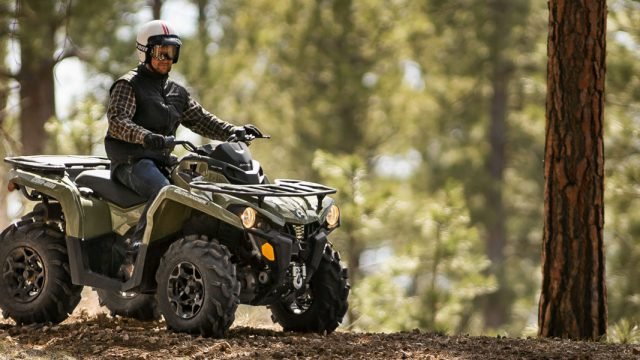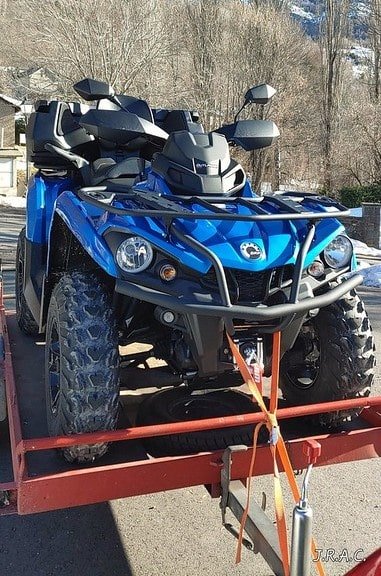The Can-AM Outlander 570 is a versatile and powerful ATV that is perfect for both work and play. With a 44 horsepower engine, it has plenty of power to get the job done, but it’s also agile and maneuverable enough to enjoy some off-road fun.
Whether you’re maintaining your property or exploring the great outdoors, the Can-AM Outlander 570 is the ideal machine for the job.
However, like any other piece of machinery, there are common problems with Can-AM Outlander 570.
In this blog post, we will outline some of the most common problems that people experience with their Outlanders, as well as provide some tips on how to deal with them. We hope that this information will help you to keep your Outlander running smoothly for years to come!
What's in this post?
Top 5 Painful Common Problems With Can-AM Outlander 570

Needs maintenance more often than usual
Maintaining your Can-Am Outlander 570 is important to prolonging the life of the vehicle. Without regular maintenance, the Outlander will begin to experience problems, such as premature wear on the brake pads and fluid changes that are difficult to do.
Additionally, bushings can fall out after only 700 miles. However, with regular maintenance and proper care, the Outlander will provide years of efficient service.
Furthermore, regular inspection will enable you to identify problems early on and take care of them before they become larger issues. Therefore, it is clear that regular maintenance is necessary in order to keep your Can-Am Outlander 570 running smoothly.
Can-AM Outlander 570 Excessive Heat
Can-AM Outlander 570 Excessive Heat is a common issue faced by riders. Heat emanates from the left panel where the leg rests, reaching temperatures of up to 150°F. This makes it challenging for riders to keep their legs in that area.
The manufacturer has identified the issue: blowing air from the horizontally positioned exhaust pipe. Can-AM is actively working on a solution. In the meantime, riders can minimize heat by turning off the engine when not riding and avoiding excessive idling.
To prevent excessive heat, riders can keep their vehicles in a shaded area and ensure proper engine ventilation. Additionally, covering exhaust pipes with header wrap can create high-temperature-resistant panels. These precautions can help riders avoid heat issues until Can-AM finds a permanent solution.
Heat shields for exhausts can be purchased to reduce radiant heat from exhaust pipes by up to 70%. To address the issue, the vent air should be forced in opposite directions from the tank and panel.

Ignition issues
Ignition issues are a common problem for owners of Can-Am outlander 570s. Fortunately, there are a few things that you can do to try and resolve the issue. First, grab a long wooden rod and tap the starter gently.
This may help to jar loose any debris that may be preventing the starter from engaging. If this does not work, you may need to replace the stock battery with a more powerful alternative. AGM or Optima type batteries are good choices as they have extra reserve cranking amps that will give your quad starter enough power to start the engine in severe winter weather.
However, if you are still having problems starting your quad, it is likely due to a more complicated issue like throttle icing or a leaking carburetor. These types of issues are more prevalent in older models of the Can-Am Outlander and have been resolved in the newer 2017 models.
Poor wheels
If you own a Can-Am Outlander 570, you may have noticed that the factory tires are of poor quality. The wheels puncture easily, which can be frustrating and costly. Fortunately, there is an easy solution. The 2016 Can-Am Outlander model comes equipped with 28” tires. If you already own a 2016 model, swapping the tires will be unnecessary.
However, if you have an older model, replacing the tires is a simple and effective way to improve the quality of your ride. Not only will you enjoy a smoother ride, but you’ll also save money in the long run by avoiding costly repairs.
Broken Shaft
A broken driveshaft is a safety hazard. Excess weight can cause it to break, resulting in loss of vehicle control. In some cases, the steering may lock up, making accidents unavoidable.
If you suspect a broken drive shaft, have it checked by a professional ASAP. While repairs can be costly, the potential cost of an accident is much higher. By taking precautions and being aware of the risks, you can help ensure road safety for yourself and others.
Safety is a top priority for BRP. They took quick action when they discovered a potential issue with the dynamic power steering shaft on certain ATV models. The shaft can break under certain circumstances, affecting steering and potentially causing injuries. Although no injuries have occurred, BRP is working closely with affected consumers to resolve the problem.
They have requested that all owners of affected ATVs contact their authorized dealer to schedule a repair at no cost to the consumer. In the meantime, they advise against any attempts to fix the issue oneself, as this could potentially make the situation worse. By taking these precautionary measures, BRP is ensuring that riders can continue to enjoy their ATVs safely and with peace of mind.






My engine drive shaft is broken. Can it be replaced without splitting the Crank case?
Hi Levi, you can but replacing an engine drive shaft without splitting the crankcase can be quite challenging and may not be the recommended method. It’s crucial to consult with a professional mechanic or your vehicle’s manufacturer before attempting such a procedure. They can provide advice tailored to your specific model and situation.
Enhance One’s Delight with Realistic Toys. Guess what there! Looking for boost the individual fun and spice things up using the mate? Lifelike toys might be simply what a person need. These kinds of realistic toys are created emulate appearance touch such as a true organ, offering a truly immersive session. Lifelike dildos are created with attention to detail, showing veins, ridges, with realistic form that feels incredibly authentic. Formed out of top-grade safe elements, giving a true sensation boosting all movements. Regardless if a person chooses a little dimension subtle and bigger and more filling, a lifelike toy exists ready for one. One of many regarding lifelike dildos is their usefulness. One can utilize them for vaginal and anal pleasure, offering a person a range of options to explore. Its sturdy and adaptable shape facilitates comfortable and gratifying interaction within assorted postures. Several true-to-life instruments also come a suction-based bottom, providing hands-free fun simple. For starting, use ample water-based lubricant for ensuring an easy and enjoyable experience. Test multiple angles and methods to uncover what else for someone. Rinse the toy well prior and subsequent to use for keeping it in top condition. Here’s what users be forced to say: “The feel and intricacy is incredible. It feels so real!” – Jessie. “This has become my go-to toy for solo play. It consistently pleases.” – Laura. “I am fond of using this alongside my lover. It adds so much enjoyment to our private moments.” – R.. Ready to experience true satisfaction? Authentic devices are ready to improve your intimate moments and give incredible satisfaction. Use one to uncover a completely new height of enjoyment!
Find The Ideal Fit. With a variety of choices available, finding the perfect natural instrument can be a bit overwhelming. Below are some advice to assist in the process.
[url=[Link deleted]Quartz Yoni Wand for Kegel Exercise[/url]
[url=[Link deleted]Vibrators and Ease Meets Enjoyment[/url] 154b598